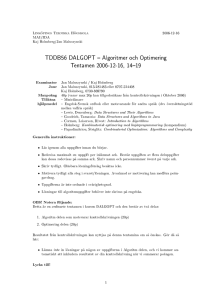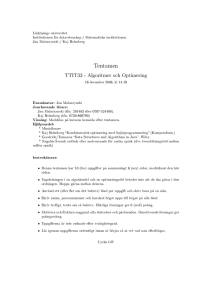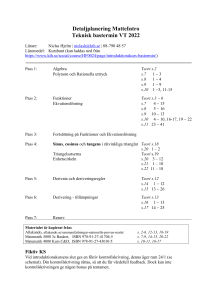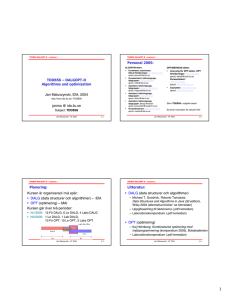Link opings Tekniska
advertisement
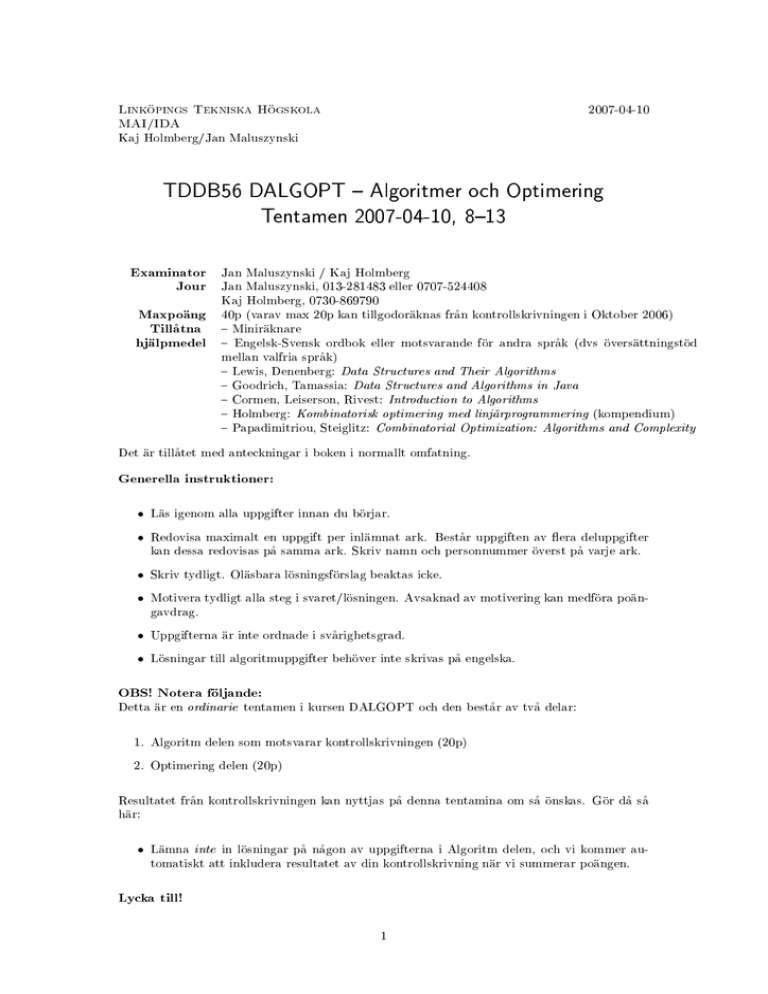
Link
opings Tekniska H
ogskola
MAI/IDA
Kaj Holmberg/Jan Maluszynski
2007-04-10
TDDB56 DALGOPT { Algoritmer och Optimering
Tentamen 2007-04-10, 8{13
Examinator
Jour
Maxpoang
Tillatna
hjalpmedel
Jan Maluszynski / Kaj Holmberg
Jan Maluszynski, 013-281483 eller 0707-524408
Kaj Holmberg, 0730-869790
40p (varav max 20p kan tillgodoraknas fr
an kontrollskrivningen i Oktober 2006)
{ Miniraknare
{ Engelsk-Svensk ordbok eller motsvarande for andra spr
ak (dvs oversattningstod
mellan valfria spr
ak)
{ Lewis, Denenberg: Data Structures and Their Algorithms
{ Goodrich, Tamassia: Data Structures and Algorithms in Java
{ Cormen, Leiserson, Rivest: Introduction to Algorithms
{ Holmberg: Kombinatorisk optimering med linjarprogrammering (kompendium)
{ Papadimitriou, Steiglitz: Combinatorial Optimization: Algorithms and Complexity
Det ar till
atet med anteckningar i boken i normallt omfatning.
Generella instruktioner:
Las igenom alla uppgifter innan du borjar.
Redovisa maximalt en uppgift per inlamnat ark. Best
ar uppgiften av era deluppgifter
kan dessa redovisas p
a samma ark. Skriv namn och personnummer overst p
a varje ark.
Skriv tydligt. Olasbara losningsforslag beaktas icke.
Motivera tydligt alla steg i svaret/losningen. Avsaknad av motivering kan medfora poangavdrag.
Uppgifterna ar inte ordnade i sv
arighetsgrad.
Losningar till algoritmuppgifter behover inte skrivas p
a engelska.
OBS! Notera foljande:
Detta ar en ordinarie tentamen i kursen DALGOPT och den best
ar av tv
a delar:
1. Algoritm delen som motsvarar kontrollskrivningen (20p)
2. Optimering delen (20p)
Resultatet fr
an kontrollskrivningen kan nyttjas p
a denna tentamina om s
a onskas. Gor d
a s
a
har:
Lamna inte in losningar p
a n
agon av uppgifterna i Algoritm delen, och vi kommer automatiskt att inkludera resultatet av din kontrollskrivning nar vi summerar poangen.
Lycka till!
1
Algoritmer
Uppgift 1. Complexity
(2p)
(2p)
a) Consider the following functions, where k 4 is a constant, and log is the logarithm of
base 2. Order them according to their growth rate, i.e. put them in the sequence f1 ; :::; f7
such that fi 2 O(fi+1 ) for i = 1; :::6. Does the set include functions with equal growth
rate?
p
nlog k ; k n ; 5n3=2 ; n log n; nk ; n3 ; k log n
Justify your answer.
b) Write a recursive procedure for computing factorial and analyze its complexity.
Uppgift 2. Stacks and Queues
The sequence of characters A B C D E is read once, character-by-character from left to right.
Each character read may be rst placed in a temporary memory or sent directly to the output. The reading operations may be interleaved with operations removing characters from the
memory and sending them to the output. In this way we obtain at the output a permutation
of the input sequence (the left-most character of the permutation is the character sent rst to
the output). Consider the permutations A C E D B and B C E A D. For each of them check
whether it is possible to obtain it if the temporary memory is:
(2p)
(2p)
a) stack
c) queue
If the answer is \yes" show the sequence of the respective operations performed to obtain it.
If the answer is \no" explain why no sequence of the operations can generate the required
permutation.
Uppgift 3. Trees
(3p)
a) Consider the following binary tree T
15
6
5
21
10
18
25
(1p) Justify that T is a binary search tree and that T is also an AVL tree.
(2p) Show the trees: T1 = Insert(12; T ), T2 = Insert(7; T1), T3 = Insert(9; T2), T4 =
(1p)
Remove(15; T3), where Insert and Remove are operations on AVL trees.
b) Consider the following arrays:
A: 1
B: 1
2 1 2 2 1 1 2 2 1 2 1 1
2 3 4 5 6 7 8 9 10 11 12 13
Which of them, if any, can represent a heap? Justify your answer by showing the respective
trees.
2
Uppgift 4. Hashing
We use an array with indices 0 to 6 to implement a hash table of size 7. The keys of the inserted
elements are integers. The hash value is calculated as the key value modulo the table length.
Show the contents of the initially empty array after performing each of the following operations
Insert(15); Insert(8); Insert(14); Remove(15); Insert(32); Insert(4); Insert(7)
when the following technique is used:
(1p)
(1p)
a) open addressing with linear probing,
b) open addressing with double hashing, where h2 (k ) = 5
(k mod 5)
Explain how removal is handled in your solution.
Uppgift 5. Sorting
(1p)
(2p)
a) Explain what it means that a sorting algorithm is unstable.
b) Which of the sorting algorithms discussed in this course are unstable? For one of them
prove that it is unstable by showing its execution on example data.
Uppgift 6. Graphs
Consider the directed graph.
4
2
1
6
3
(1p)
(1p)
(1p)
5
a) Show the order of visiting its nodes under a depth-rst search starting in node 1. Is there
only one such order?
b) Show the order of visiting its nodes under a breadth-rst search starting in node 2. Is
there only one such order?
c) Show a topological sort of the graph. Is there only one topological sort of this graph?
3
Optimering
Uppgift 7
Betrakta foljande LP-problem.
min z =
d
a
2x1 + x2
x1 + 4x2
x1 ;
(3p)
(2p)
(2p)
(1p)
x2
x2
5
5
0
a) Los problemet med simplexmetoden. Ange en optimallosning samt vilka primala bivillkor
som ar aktiva. Ange en dual optimallosning. (Observera att inga ytterligare berakningar
behovs for att nna duallosningen.)
b) Formulera LP-dualen till problemet. Kontrollera att duallosningen i uppgift a ar till
aten.
Kontrollera explicit att komplementaritetsvillkoren ar uppfyllda.
c) Skulle en ny variabel, x5 , med m
alfunktionskoeÆcient c5 = 1 och bivillkorskoeÆcienter
a5 = (1; 1)T
andra den optimala baslosningen?
d) Hur andras det optimala m
alfunktionsvardet om hogerledet okas lite, dvs. man satter
b1 = 5 + ", d
ar " ar ett litet positivt tal.
Uppgift 8
(3p) Ange en optimal duallosning till tillordningsproblemet med foljande kostnadsmatris.
losningen unik? Ange aven en till
Ar
aten men inte optimal duallosning.
07 7 71
@7 7 7A
7 7 8
Uppgift 9
Betrakta det s.k. frivilliga billigaste vag-problemet, dar man f
ar skicka en enhet fr
an startnoden
till slutnoden om man skulle vilja, dvs. om man skulle tjana p
a det. (En negativ kostnad ar
vinst).
(2p)
(1p)
(3p)
a) Formulera problemet i variabler och bivillkor som ett LP-problem. (Tank p
a mojligheten
att anvanda olikhetsvillkor.) Man f
ar anta att ingen negativ cykel nns.
b) Formulera LP-dualen till problemet.
c) Finn primal och dual optimallosning for fallet dar alla b
agkostnader ar positiva. Veriera
att b
ada losningarna ar till
atna.
4
Uppgift 10
Antag att man vill nna K b
agdisjunkta vagar fr
an en given startnod till en given slutnod.
(Tv
a vagar f
ar allts
a inte inneh
alla n
agon gemensam b
age.)
(1p)
(2p)
a) Formulera problemet som ett linjart odesproblem.
b) Finn det maximala antalet b
agdisjunkta vagar fr
an nod 1 till nod 8 i nedanst
aende graf.
(Anvand kand metod.) En hjalpsam person har angivit vagen 1 - 4 - 3 - 5 - 6 - 8. Utnyttja
denna som startlosning.
2
5
6
3
1
7
4
5
8
